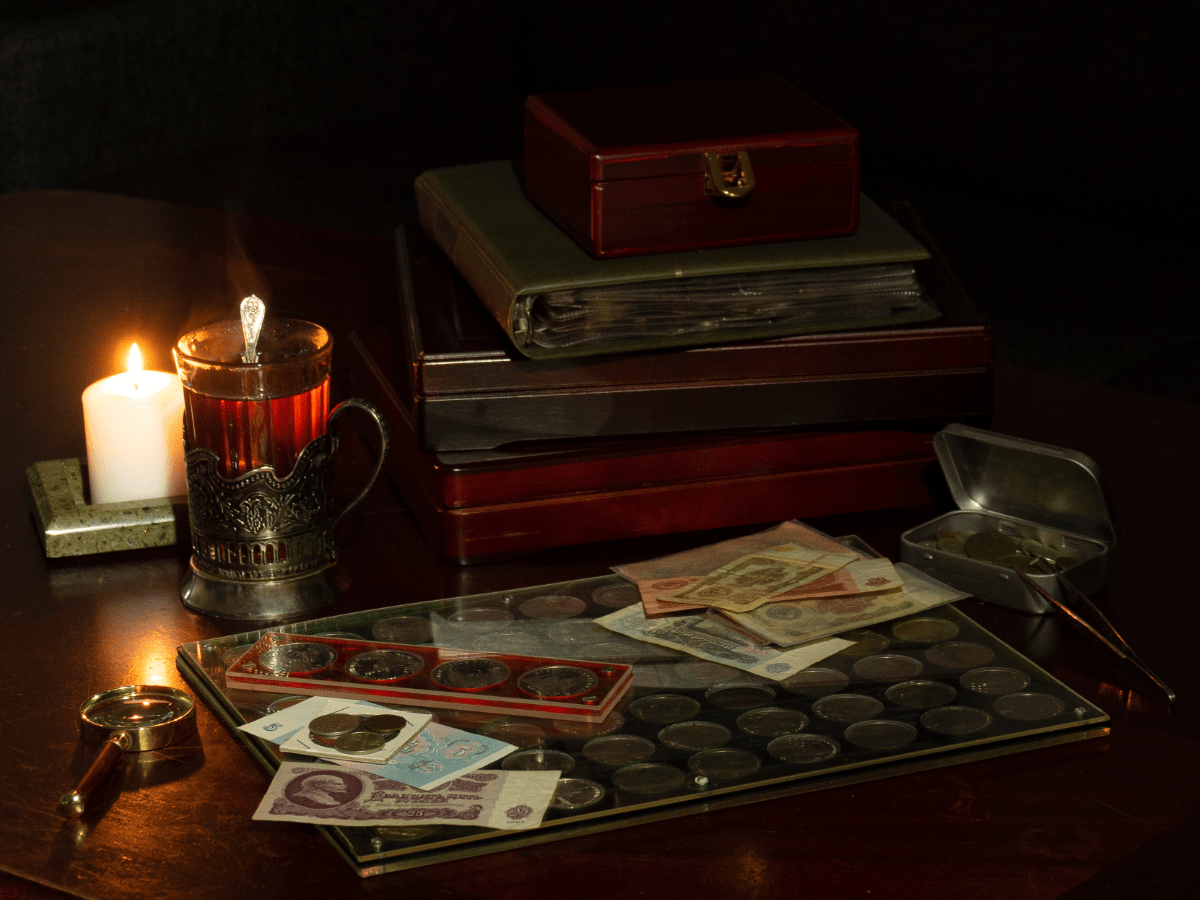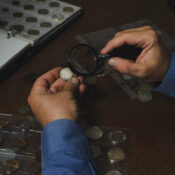
Knowing When to Let Go of Your Collection
Collecting isn’t just a hobby, it’s a part of who you are. Every piece holds a memory, a story, a moment in time that you chose to capture. Over the years, you pour your heart, your time, and sometimes a good chunk of change into building a collection that reflects your passions. But what happens when life shifts? Maybe the walls are feeling a bit too crowded, or perhaps the market is offering prices too tempting to ignore. Whatever the reason, letting go isn’t easy. But it might be time to ask yourself: Is it time to part ways with some of these treasures?
In this post, we’ll talk about the emotional signals that it might be time to let go, the market factors that can guide your decision, and how to approach selling in a way that honors both your collection and the memories attached to it.
Table of Contents:
Emotional and Psychological Signs It Might Be Time to Let Go
Sometimes, the first clue that it’s time to let go of a collection isn’t about money or market trends; it’s about how you feel. You might not even realize it at first, but those subtle shifts in how you connect with your items can speak volumes. Here are a few signs to look for:
When Joy Becomes a Chore
Remember when caring for your collection felt like a joy? If now it just feels like one more thing on your to-do list, that’s a red flag. Dusting, organizing, or even just looking at your pieces might start to feel more like work than pleasure. It happened to me with a set of recovered bottles I once loved. One day, I caught myself dreading the dusting, and that’s when it hit me…the excitement was gone. If that sounds familiar, it might be time to consider letting some pieces go.
Out of Sight, Out of Mind
Take a look around. How many pieces are tucked away in boxes or closets, rarely seeing the light of day? If they’re not part of your daily life, ask yourself why you’re holding onto them. A decluttering expert once said, “If you’re not stopping to admire or enjoy the things you own, they’re just taking up space.” That struck a chord with me. If you can’t remember the last time you really looked at a piece, it might be ready for a new home.
Guilt and Obligation Over Enjoyment
Some pieces come with strings attached. Maybe it’s a gift from someone who’s passed on, or an item that reminds you of a specific time or place. Those memories can be powerful, but they can also keep you stuck holding onto things you don’t actually love. If the main reason you’re keeping something is because you’d feel guilty letting it go, it might be time to reframe your thinking. You’re not losing the memory by selling the item (the memory will always be with you, right where it belongs) you’re just making room for new experiences.
When Your Collection Feels Like Your Identity
For a lot of us, our collections are part of who we are. It’s more than stuff, it’s a story. But there’s a fine line between cherishing that connection and feeling trapped by it. Psychologists talk about the “endowment effect,” where we tend to overvalue things simply because they’re ours. I know I’ve been guilty of this thinking, “No one will love this piece like I do.” But the truth is, sometimes letting go can open up space to find new pieces that speak to who you are now, not who you were then.
A Shift in Passion
Our interests change over time, and that’s okay. Maybe what once lit you up just doesn’t anymore. Or maybe you’re feeling the urge to streamline and focus on fewer, higher-quality pieces. Auction experts say it’s not uncommon for serious collectors to sell entire collections multiple times in their lives, each time refining or redirecting their focus. If your heart is pulling you toward something new, it might be time to let go of the old to make space for the next chapter.
In the end, it’s about checking in with yourself. How do you feel when you look at your collection? If it’s more stress than joy, more obligation than excitement, that’s your signal. Letting go isn’t easy, but it can also be the first step toward feeling lighter, freer, and more in tune with who you are now.
Market Timing: When the Numbers Speak
Emotions aside, sometimes it’s the market that nudges you toward letting go. You know the saying, “Timing is everything?” Well, in the world of collectibles, it couldn’t be truer. Whether you’re holding onto a collection of vintage toys, rare coins, or fine art, paying attention to market trends can help you make a smarter move.
The Nostalgia Curve
Think back to the things you loved as a kid. Those comic books, action figures, or vinyl records, they were more than just stuff; they were a snapshot of a moment in time. But nostalgia isn’t just personal. It’s a powerful driver in the collectibles market.
Here’s how it works: Collectors are most active (and willing to spend big) between their 30s and 60s. Why? They’re at the peak of their earning years and looking to reclaim pieces from their youth. But as they age beyond 65, the urge to collect can fade, and so does demand. That’s when the market for those items can cool off.
For example, a few years ago, collectibles from the ‘60s and ‘70s were hot because that generation was hitting their prime collecting age. Now, as those collectors are getting older, items from the ‘80s and ‘90s are having their moment. If you’re holding onto items from a specific era, take a look at the age group that would be most interested. If they’re starting to downsize or shift away from collecting, it might be time to consider selling before the demand dips.
Riding the Wave vs. Dodging the Crash
Markets are like roller coasters: thrilling on the way up but not so fun when they drop. We saw it happen with trading cards during the pandemic. Prices for some cards went through the roof, only to come crashing down once the world started reopening.
It’s the same with any collectible market. A sudden spike in demand can feel exciting, but bubbles burst. A sports card index, for example, shot up 337% from 2019 to early 2021. Then it fell 30% over the next two years. If you’re sitting on something that’s skyrocketed in value, ask yourself: Is this a long-term trend, or are we on the edge of a cliff?
You don’t have to time the market perfectly to come out ahead. But if prices have shot far beyond historical norms, it might be a good moment to cash in before the wave crashes.
Buyer’s vs. Seller’s Market
Just like real estate, the collectibles market swings between buyer’s and seller’s markets. When demand is high and supply is low, you’re in the driver’s seat as a seller. But when a category falls out of fashion or the market cools, buyers gain the upper hand.
Take a look at recent auction results for items similar to yours. Are prices climbing, or are they stalling? Are pieces selling quickly or lingering unsold? If you notice a lot of items going unsold or selling for less than they did a year ago, you might be in a buyer’s market. But if demand is still strong and prices are holding steady, that’s your cue to consider striking while the iron’s hot.
Economic Indicators
Sometimes it’s not about the item itself but the world around it. Economic conditions can play a big role in how people spend on collectibles. When inflation is high or interest rates spike, people tend to tighten their wallets, and non-essentials like collectibles can take a hit.
On the flip side, in times of uncertainty, some collectors shift to tangible assets like gold, silver, and rare coins as a safer bet. Pay attention to what’s happening in the broader economy. If people are flocking to tangible assets, it might be a good time to sell off items that fit that category.
And don’t forget seasonality. Items like sports memorabilia might see a bump during major championships, while vintage holiday decor tends to peak closer to the holidays. If your collection aligns with a specific time of year, that could be your selling window.
When Personal Needs Outweigh Market Trends
Sometimes, the best time to sell isn’t about the market at all, it’s about you. Maybe you’re downsizing, paying for a big expense, or just ready to simplify. The market doesn’t have to be at a peak for you to make a good move.
I’ve known collectors who waited years for that “perfect” time to sell, only to miss it and feel stuck. In reality, selling when prices are good (not necessarily perfect) can still bring a solid return. So, if parting with your collection aligns with your life right now, that’s reason enough to act.
Expert Insights: What Estate Planners and Auctioneers Say About Letting Go
Selling a collection can easily turn into a complex process that can feel a little daunting. The good news? Plenty of people have walked this path before, and they’ve learned a lot along the way. Here’s what estate planners, auction professionals, and collection advisors suggest when it comes to letting go:
Plan Early
Here’s a tough truth: the longer you wait to plan, the less control you might have over the outcome. I’ve seen collectors who intended to handle it “someday” and ended up with disinterested heirs selling valuable pieces for pennies on the dollar. That doesn’t have to be you.
Start thinking about your collection’s future now, even if you’re not quite ready to sell. Map out which pieces you want to keep in the family, which you’d like to donate, and which might be worth selling to fund the next chapter of your life.
By planning ahead, you get to choose where each piece lands. You can handpick the auction house that best fits your collection, negotiate better terms, and time the sale when the market is strongest. Otherwise, if you leave it to chance or family members who don’t share your passion, your collection could end up scattered or undersold. The bottom line? Take control now, while you still can.
Have Candid Conversations with Family
I can’t tell you how many times I’ve heard stories about heirs being handed collections they didn’t want or understand. Before making any big moves, talk to your family. Do they want your collection? Are there a few pieces that hold special meaning to them?
If they’re not interested, that’s okay. It’s better to know now than to leave them with a burden later. You could sell off a significant portion and keep a few sentimental pieces for those who truly care. Or, if you have a family member who shares your passion, you could focus on passing down just a few key items rather than the whole lot.
Either way, having those conversations now can spare everyone a lot of confusion and prevent potential conflicts down the line.
Think About Your Legacy and Intent
Why did you start collecting in the first place? Was it about capturing a moment in time? Creating a legacy? Or maybe it was just for the sheer joy of it. Whatever the reason, take some time to think about what would make you happiest as your collection moves on.
Some collectors love the idea of seeing their pieces go to new homes where they’ll be just as cherished. Others hope to keep the collection intact, maybe donating it to a museum or local institution. There’s no right or wrong answer.
For some, selling during your lifetime can feel like a reward as you get to see your pieces find new admirers and maybe even enjoy some recognition for your efforts. Plus, it can free up funds for other passions or projects.
On the flip side, if the idea of parting with your collection now doesn’t sit well, consider making plans for a future donation or outlining specific instructions in your estate plan.
Know What You Have, Get a Professional Valuation
You’d be surprised how many collectors don’t actually know the true value of what they own. I once met a man who had been collecting vintage watches for decades, only to find out that one he’d bought for $500 was now worth $15,000. The catch? He didn’t even realize it until he brought in an expert.
That’s why a professional valuation is crucial. You might have pieces that have appreciated significantly over the years, while others haven’t moved much. A trusted appraiser can provide clarity and help you identify which pieces are worth selling separately and which are better off as part of a lot.
Plus, having a current valuation can prevent any unpleasant surprises down the road, like discovering you owe capital gains tax on something you sold for way more than you thought it was worth.
Consult Independent Advisors and Auctioneers
If the idea of sorting through your collection feels overwhelming, you don’t have to go it alone. At Blue Box Auction Gallery, we work with collectors every day to develop strategic selling plans.
Whether you’re selling a single piece or an entire collection, a good advisor can help you decide the best venue (auction, private sale, consignment), the ideal timing, and how to break up the collection if needed.
Auction houses often have consignment directors who can walk you through the process and recommend the best strategy for maximizing returns. And if you’re not ready to sell everything at once, they can help you ease into it by testing the market with just a few pieces.
Easing the Transition
Letting go of a collection can feel like letting go of a part of yourself. That’s why it’s important to approach the process with care.
You might start by selling a few less-important pieces to “test the waters.” Often, seeing your items find appreciative new homes can be reassuring and even gratifying.
Some collectors also find it helpful to document their collection’s story before parting with it. Take photos, write down the stories behind each piece, or even create a scrapbook. This way, you’re preserving the memories even as the items themselves move on.
And remember, this is a journey. Take your time. Surround yourself with trusted advisors who respect both you and your collection. Whether you choose to sell now, later, or never, the decision should feel right for you: not rushed, not forced, but a natural step forward.
Practical Steps to Evaluate Your Readiness
You’ve walked down memory lane with your collection, weighed the emotional pull, and maybe even started to consider the market. But how do you turn that growing feeling into action? Here’s a step-by-step approach to guide you through the process, along with a few red flags that might signal it’s time to move forward:
Take Inventory and Assess Your Connection
Start by walking through your collection, piece by piece. Grab a notebook and make a list of each item or set, along with a gut-check reaction. Does it still light you up, or do you feel nothing but obligation? Is it proudly displayed, or has it been packed away in a closet for years?
A big red flag is coming across duplicates you forgot you owned or boxes you haven’t opened in ages. I once found an old toy set that I didn’t even remember buying. That’s a clear sign it’s time to let go.
Ask yourself:
- Do I still enjoy caring for these items?
- Are they adding to my life, or just taking up space?
- Would I miss this if it were gone?
If your answers lean toward indifference or even relief at the thought of parting with certain pieces, you’re already halfway there.
Research Market Value (Get Realistic)
Next, it’s time for a reality check. What are these items actually worth today? The market moves fast, and values can shift dramatically.
Look up recent sale prices for similar pieces. Check auction results, browse collector forums, or consult a reputable appraiser. Don’t be surprised if some items aren’t worth what you thought, or if others have unexpectedly surged in value.
Keep in mind, though, that just because something is valued at a certain amount doesn’t mean it will sell for that price. If you’re emotionally attached, it’s easy to overestimate what a piece is “worth.” That’s the endowment effect in action; the tendency to value something more simply because it’s yours.
A practical tip? Make it a habit to revisit your collection’s value once a year, even if you’re not ready to sell. It keeps you in the know and prevents surprises down the line.
Identify Red Flags in Your Life Situation
Sometimes, the decision to sell isn’t about the market: it’s about what’s happening in your life.:
- Space Constraints: Are your collectibles crammed into closets or overflowing into other rooms? If you’re tripping over boxes or considering off-site storage, it’s worth asking: Do these items still bring enough joy to justify the hassle?
- Financial Considerations: Are you sitting on a valuable collection while struggling to cover other expenses? Or maybe you’re eyeing the collection as a potential source of funds for a big goal like a child’s education, a new business, or even retirement. If the collection’s value could help you achieve something important, that’s a sign it might be time to sell.
- Physical Ability and Care: Collections require upkeep, whether it’s dusting porcelain, protecting paper items from moisture, or rotating fragile pieces to prevent fading. If caring for your items is becoming a burden (or if health issues make it difficult to keep up) it might be time to pare down while you still have control over the process.
Test the Waters with a Partial Sale
You don’t have to sell everything at once. Start small. Pick a handful of pieces that hold less emotional weight and see how it feels to let them go.
This approach can be a great learning experience. You get a taste of the selling process without diving in headfirst. And if you discover that parting with a few items actually feels good, that’s a strong signal you’re ready for more.
But be honest with yourself: If you sell a few pieces and immediately feel the urge to fill that space with new acquisitions, you might not be emotionally ready yet. And that’s okay. Take your time.
Choose the Right Selling Method
When you’re ready to move forward, think about the best path for your specific collection:
- Auction: If you have high-value or rare pieces, an auction might be your best bet. Competitive bidding can drive up prices, and established auction houses have access to the right buyers. Just remember that they’ll take a percentage of the final sale.
- Direct Sale to a Collector or Dealer: This can be quicker and more straightforward than an auction. You might not get top dollar, but the convenience can be worth it. Just be sure you know the market value before negotiating and verify the reputation of the buyer.
- Local Shows or Shops: For lower-value items, local venues can be an easy way to sell. Again, check pricing ahead of time so you don’t inadvertently undersell.
- Donation: Some pieces might not be worth the hassle of selling but could make a great gift to a museum, library, or younger collector. Plus, donations can come with tax benefits.
Plan the Logistics and Prepare for the Emotional Impact
Once you’ve decided to sell, it’s time to get organized. Make a detailed inventory of everything you’re letting go of complete with photos, condition notes, and any supporting documentation (like certificates of authenticity).
Think about how you’ll handle the actual sale. Will you be on-site at the auction? Will you ship items directly to buyers? How will you handle the inevitable “empty space” after your collection is gone?
That last point might be the hardest. Watching those empty shelves or blank walls can be a bit of a gut punch, especially if your collection has been part of your life for years.
Here’s a thought: Turn that empty space into a blank canvas. What new chapter could you start with that newfound freedom? Maybe it’s time to travel, dive into a new hobby, or even start a smaller, more curated collection that truly speaks to who you are now.
Embracing a New Chapter
Letting go of a collection can feel like saying goodbye to a part of yourself. But it doesn’t have to be a loss; in fact, it’s often a step forward. Think of it as turning the page to a new chapter rather than closing the book.
Maybe your collection has already served its purpose. Maybe it was all about the thrill of the hunt, the stories behind each piece, or the knowledge you gained along the way. Or maybe your life is shifting, and those antique clocks or stacks of comic books just don’t fit the way they once did.
Whatever the reason, letting go isn’t a sign of failure. It’s simply the next phase in a collector’s journey. Plenty of seasoned collectors have been there, and many feel a sense of relief and even pride afterward; relief in knowing their treasures are being appreciated by someone new, and pride in making a smart decision at the right time.
So, as you weigh the emotional signals, analyze the market trends, and consider the expert advice we’ve discussed, remember that this decision is yours to make. And when you do decide to let go, do it on your terms. Be thoughtful. Be strategic. Be grateful for the role your collection played in your life.
Because at the end of the day, the true value of a collection isn’t in what it sells for; it’s in what it brought to your life while you owned it. Those memories, those stories, those moments of joy, they stay with you forever, even after the physical pieces move on to new homes.
Recent Posts
Coin Authentication: A DIY Guide for Collectors
Preserving History: Expert Tips for Caring for Civil and Revolutionary War Militaria
Coin-Ops: Relics of Yesterday, Treasures of Today
All Categories
Sell With Confidence
The best auction finds don’t wait around.
Be the first to see what’s coming up—sign up for exclusive previews and expert insights.



